Church: Owen UCC History (1910-1979)
Contact: Janet
Surnames: AUSTIN BABB BARDEN BEEBE BELL
BOLMON BOVEE CARTER CLARK CLAYBAUGH CLAYBOUGH COOK FAVILLE GLICK
GOESSLING GRIFFIN GUTHRIE HALL HARRIS HOSELOW HOTCHKISS HAIGH
HAMILTON HOWARD HUGHES JOHNSON JONES KRASIN LEWIS MAYNARD MEINHARDT
NISSEN NORENBERG OWEN PETERSEN PFAFFMAN POWE POWELL ROWE SAMPSON
SARGENT SHEPHERD SPENCER STATS STOKER SWANSON TURNEY VELLEMONTE
WEIRICH WICKS WILEY WILLON WINRICH
Owen, WI United Church of
Christ History (1910-1979)
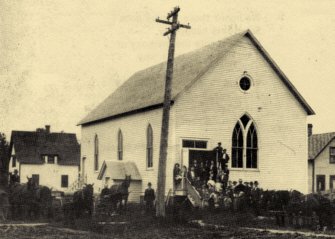
Original Congregational Church of Owen, WI
Ready to leave for the Sunday School Picnic
HISTORY OF FIRST CONGREGATIONAL UNITED CHURCH OF CHRIST
Owen, Clark County, Wisconsin
(by Prudence Turney)
The First Congregational United Church of Christ of Owen dates back
to 1894 when a Sunday School was organized. This was done before
the original schoolhouse was built. The Sunday School was held in
the homes of Mrs. W. M. Barden and Mrs. Louis Johnson under the
leadership of George Howard. This arrangement was temporary until
the year 1898 when a Congregational missionary, the Rev. John
Willon, visited Withee and held Camp Meetings there and at Babb's
Mill. The Rev. Willon visited Owen and in December of 1899 inspired
the people of Owen to establish a permanent Sunday School under the
leadership of A. G. Johnson and his co-laborers.
In early 1899 Rev. James Austin was placed in charge of missionary
work for the area and services were conducted from time to time in
homes, schools, and tents during the summer months.
On December 4, 1903, the first Ladies Aid was organized at the home
of Mrs. F. C. Griffin. Members present were: Mrs. G. F. Bolmon,
Mrs. F. C. Griffin, Mrs. C. M. Hall, Mrs. B. A. Harris, Mrs. J. F.
Hughes, Mrs. A. R. Owen, Mrs. R. D. Stoker, and Mrs. J. P.
Weirich.
The Ladies Aid was organized before the Congregational Church and
later become the women's organization of the church. Today, the
Women's Fellowship is still very active and supportive of church
activities.
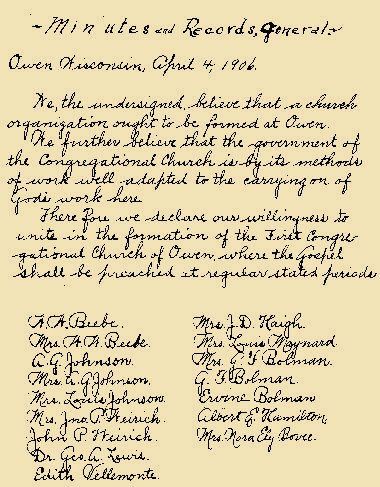
The preliminary organization of the church was held in the
schoolhouse Jul 8, 1906. It was voted unanimously to organize a
Congregational Church in Owen. The Rev. Abraham Bell conducted the
meeting and read the order of procedure from the Council Manual and
"letter missive." On Jul 13, 1906 invitations were planned to
pastors and delegates for the organizational meeting of the
proposed church. By unanimous vote a "letter missive" was issued to
call a council on Jul 16, 1906 at two o'clock to complete the
work. The Committee elected to write the letter was A. G. Johnson,
W. W. Beebe, and Mrs. J. P. Weirich.
On Jul 16, 1906, a council meeting was convened in the KOTM Hall
(Knights of the Maccabees) with Dr. Homer N. Carter presiding. A
history of the religious work in Owen was read by Mrs. Louis
Johnson followed by questions from the council as to reasons for
organizing a church in Owen.
The Council moved to meet in private session which was interrupted
by an invitation to take a ride on the train, used by the John S.
Owen Lumber Company for logging purposes, to a camp where a steam
loader was at work. The invitation was unanimously, precipitately,
and gratefully accepted and the private session of the council was
held in the caboose, all motions being carried at the rate of about
twelve miles an hour.
(Quoted from early
minutes)
On February 10, 1907, A. R. Owen's offer of a lot on which to erect
a church was unanimously accepted, on on August 5th, plans were
submitted by the Krasin Brothers, Contractors, for the proposed
church building and accepted by the building committee. Old church
records are not clear about how money was raised to pay for the new
building. Excerpts read as follows:
September 13, 1907 --"A motion was made by Mr. Bolman that the
Trustees of the Church be instructed to fill out application to the
Church Building Society for a grant of eight hundred dollars."
March 11, 1 908 - - "No word, as yet, received from Congregational
Building Society in regard to the promised aid in building of
church. Mr. Wiley reported that the contractors were to receive 50%
of the sum named in the contract when the roof was on and 50% of
the balance when the building was plastered."
May 11, 1 908 - - "Resolved that the Trustees of the First
Congregational Church, consisting of Rev. Rowe, A. G. Johnson, G.
F. Bolmon, T. H. Wylie, and J. P. Weirich, having reported that
they had secured funds enough with a grant promised from the
Building Society of the Congregation Church, and that they have
erected a building, and some has been accepted. They further report
that the building society have advised them, that, owing to the
stringency in the money market, the promised funds have not been
available, that we hereby authorize the above named Building
Committee to negotiate a loan from the State Bank of Owen for a sum
not to exceed $1500 payable on or before six months from date, with
interest at 7%. When said grant from the Building Society of the
Congregational Church is received, some shall be endorsed as part
payment thereon."
June 23, 1908 - -"A letter was read from the Congregational
Building Society in which it was understood that all indebtedness
against the church building must be paid before a loan could be
made. A motion was therefore made that Mrs. Bolmon, Rev. Rowe, and
J. Weirich act as a committee to see the Officers of the Ladies Aid
to advise them of the circumstances and as certain if the funds in
their possession could not be secured for that purpose. A motion
was made and carried that the church take an annual collection for
the Church Building Society. Resolved that this church approve of
the execution and delivery to the Congregational Building Society
of the mortgage or mortgages required by said society according to
the conditions upon which aid is voted and agrees that all
installments provided for therein shall be promptly paid."
Church services were first held in a room of the old wooden school
house, then in the gymnasium of the new school building, which is
now the grade school, until a church building was erected. The
church was built on chicken pie suppers served in the room under
the stage of the old Opera House, the only equipment there being a
table and benches, a stove and dishes--everything else had to be
brought in.
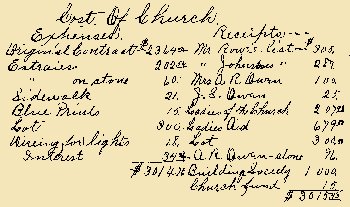
The years following 1908 were years of quiet growth through the
efforts of the congregation, the Ladies Aid, and hard-working
pastors. Owen changed from a lumbering town to one of industry
amidst a growing agricultural community. In 1921, a parsonage was
built to the south of the church.
In the winter of 1941, the Rev. William P. D. Powe returned to
military service, leaving his wife, Fern, and son, Robert, in the
parsonage. On Sunday morning, March 16, 1941, both the church and
parsonage were completely destroyed by fire. The contents of the
church were lost, but most of the furniture in the parsonage was
saved. The following Tuesday a meeting of the Church Board was held
at Lizzie Williams' home to plan for church services during the
time that the congregation would be without a church building.
Father Ortmayer of St. Katherine's Episcopal Church offered the use
of the Community Hall for services Sunday afternoons and evenings
this offer was gratefully accepted. The insurance policy paid $3500
after the fire. However, it was discovered that a $1000 grant from
the Church Building Society and a mortgage loan for $1000 were both
outstanding, leaving $1500 with which to reconstruct the
church.
Dr. Wicks met with the Board and advised that all possible speed be
given to securing a good minister to take charge of the field and
erection of the new church building. Sunday evening, March 23,
1941, services were resumed in the Episcopal Community Hall with
Dr. Theodore Faville, State Superintendent of Congregational
Churches, presiding, and he advised that conference funds were
available for rebuilding the church. A building committee was
appointed: George Winrich, Chairman, Elmer Hoselow, and Robert
Nissen, with Prudence Turney to act as secretary. The committee was
empowered to purchase a parsonage at a cost not to exceed $3000.
The Oscar Griebenow home was purchased for $2700 and has continued
to be the home of the minister.
Dr. Wicks assisted the congregation in hiring Wesley A. Hotchkiss,
a student at Northland College, as a minister. He preached his
first sermon on Jun 15, 1941, and assisted the contractor with
carpentry throughout the summer, in addition to his pastoral
duties. In September, he was married. As the parsonage had been
rented, he and his wife, Mary Ellen, lived in the upstairs of the
Hoselow residence.
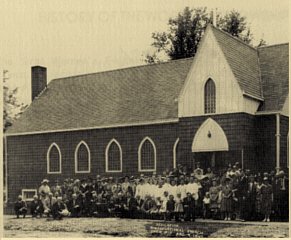
Dedication of the new church, August 9, 1942
The building of the church progressed rapidly during the summer and
fall and on December 21, 1941 the first service was held in the new
church at which time Rev. Hotchkiss delivered his Christmas sermon.
The church locked many of the finishing touches the rough floor was
covered with building paper and folding chairs were used, but it
was a most happy occasion. A beautiful silk flog was presented by
the living charter members of the Ladies' Aid. The finishing work
on the church progressed and on August 9, 1942, the dedication of
the new church took place. Dr. Charles Wicks and Dr. Howard Jones
of Madison assisted Rev. Hotchkiss in the morning service. Everyone
enjoyed a picnic dinner, including the rural churches of Reeseberg
and Wolter's Corners, who were guests. At two o'clock in the
afternoon, Dr. Theodore Faville gave the dedication sermon. The
mortgages on the church were burned during an afternoon service on
April 14, 1 946.
The church continued to grow in membership, and by the year 1956
the need for additional space resulted in an addition to the
church, which enlarged the sanctuary and dining room, and added a
new kitchen, Sunday School rooms, and pastor's study. Thanks to
local banks for their financial support, the labor of the men and
women of the church, and the poster, the Rev. Ralph Claybaugh, the
addition to the church was completed and dedicated May 26, 1957.
The Rev. Myron Glick a former minister of our church, was guest
speaker for the morning service and the Rev. Jess Norenberg, State
Superintendent, was speaker for the dedication service in the
afternoon.
The years from 1957 to 1961 saw the completion of the merger of the
Congregational Christian Churches and the Evangelical and Reformed
Churches into the United Church of Christ. On May 7, 1961 the Owen
Congregational Church adopted a new constitution that aligned it
with the new United Church of Christ.
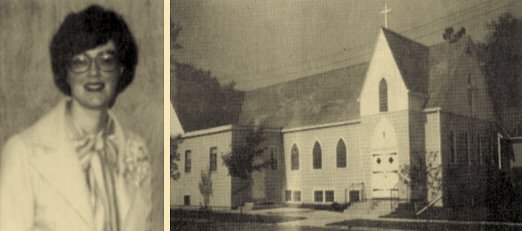
Pastor Margaret E. Shepherd & Owen, WI Congregational Church
in 1981
The following is a list of ministers who have served the
Church:
Rev. James Rowe (1906-1910), Rev. A. W. Cook (1910-1914), Rev. W.
H. Sargent (1914 -1920) Rev. E. C. Clark (1920-1922), Rev. W. H.
Sargent (1922-1925), Rev. W. P. Powell (1925-1936), Rev. P. F.
Pfaffman (1937-1939), Rev. Wm. P. D. Powe (1939-1941), Rev. Wesley
Hotchkiss (1941-1944), Rev. Walter Spencer (1944-1945), Rev.
Clarence Guthrie (1945-1947), Rev. Myron Glick (1947-1951), Rev.
Arthur Meinhardt (1951-1954), Rev. Clarence E. Guthrie (1954-1955),
Supply Rev. Ralph Claybough (1955-1963), Rev. Robert Goessling
(1964-1969), Rev. Hilding Petersen (1969-1972), Kurt Sampson
(1972-1974) Student Pastor Donald Stats (1974 -1976), Student
Pastor Rev. Loren Swanson (1976-1979), Rev. Margaret E. Shepherd
(1979 - ).





